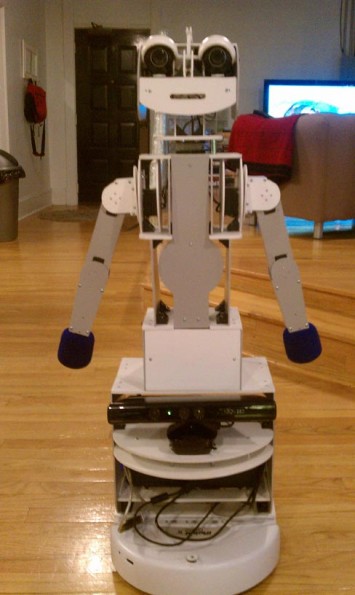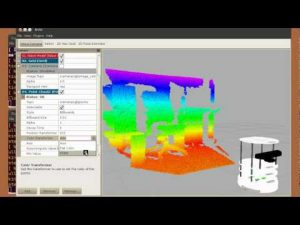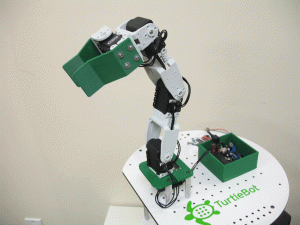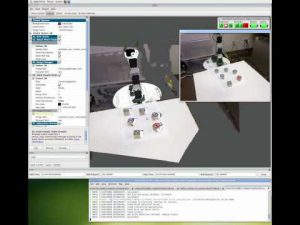The objective of this article is to present the new TurtleBot2 (Kobuki base)[1], developed by Yujin Robotics (Korea) and Willow Garage (USA), and to present a set of research projects done with this platform.
The TurtleBot2 is a diferential drive kinematics mobile robot developed for research and educational purposes, and intended to replace the previous iRobot Create platform, while keeping the software compatibility with the TurtleBot. TurtleBot2 has its own ROS software repository, that includes simulation packages (http://www.ros.org/wiki/kobuki).
The available ROS packages provide all the software you need to get the robot running and comes with built-in advanced capabilities like manipulation, navigation and mapping to help you develop applications right out of the box. There is a high number of ROS packages for robotics you can use with Kobuki, from computer vision libraries like OpenCV, or PCL to low level component drivers and advanced state of the art algorithms.
In summary, the new Kobuki platform includes the following enhancements:
-Accurate odometric measurement
-Open control protocol, previous iRobot interface cable not needed
-Higher autonomy (7 hours large battery / 3 hours small) vs 1.5 hours of Create
-Higher payload (5Kg vs 2Kg)
-Higher speed (0.65 m/s vs 0.5 m/s)
-Higher mobility, higher wheel diameter and ability to climb obstacles up to 12 mm.
Due to its reduced price (it is the cheapest platform that supports ROS) and to its wide use, the number of projects making use of it is high. We have listed some of them grouped by categories. The TurtleBots are mainly used in AAL (Ambient Assisted Living), as a domestic robot able to perform assistance tasks, in research of navigation, localization and mapping and as an educational tool. Less actively, the robot is also used in multi-robot systems, mobile manipulation and tele-operation. The most relevant use cases are detailed next:
- AAL : Ambient Assisted Living
- Robot able to bring a person water and medicines in a domestic environment[2].
- As an agent able to provide services in multi-agent cognitive architectures applied to home environments[3].
- As a robot assistant, acting as a telepresence system able to monitor the health status and help elderly at their homes[4].
- As a system that combines WSNs (portable and distributed in the environment) with home robots with the purpose of detecting person falls reliably, thus reducing the number of false positives. The robots provide the caregivers with real time information, so they can asses which is the appropriate intervention in case an emergency event is detected[5].
- HRI : Human Robot Interface
- Development of humanoid torso robots. One of the best examples is the POLYRO robot (oPen sOurce friendLY Robot)[6], that integrates a torso made of Dynamixel servos and a stereo-head of Logitech PTZ cameras.
- Development of gesture based interfaces, specific for persons with upper extremity mobility impairments. A gesture lexicon is develped and a recognition system for this lexicon in order to control a service robot[7].
- Navigation, localization and mapping based on Kinect (Slam 2d y 3d).
- Visual odometry algorithms combined with dead reckoning and gyro as input to an Extended Kalman Filter [8]
- Extensions of static 3D reconstruction algorithms based in Kinect and their adaptations and extensions to generalized 3D mapping on mobile platforms or persons in motion[9].
- Localization of Radiofrequency sources with directional antennas. Development of algorithms to filter and identify the signal origin based on the received signal strength indication (RSSI).
- Educational
- Educational tool to teach programming and mechatronics. Traditional robotic platforms for education can be divided into two categories: research platforms (expensive, precise platforms usually oriented towards research in robotics and related industries), cheap robotic kits – usually intended for schools and hobbyists[10]. From this point of view, the Kobuki robot offers high complexity at an affordable price.
- As a tool for education in advanced robotics: autonomous behaviours, artificial vision, localization and mapping, trajectory planning and execution, kinematics, software engineering, mathematical concepts (geometry, trigonometry, and linear algebra)[11].
The TurtleBot2 is clearly useful as a demonstrator of service robot applications, but due to its reduced cost, and to the fact that it is a tested component with robust and validated behavior, it is highly probable that there are a number of applications where the robot can act as a part of the final service robot and not only as a part of a prototype. For this purpose, the robot platform has the advantage of having the corresponding certifications and approvals for its use in a domestic environment, so its integration or adaption will reduce the final number of essays and certifications.
As we have noted, the TurtleBot2 is the cheapest modular robot platform that supports ROS, but the high level and scope of the listed works proves that it is possible to perform top-level research even working with low cost platforms.
[2] Victor Emeli Alan R. Wagner Charles C. Kemp, “A Robotic System for Autonomous Medication and Water Delivery”, Technical Report – Georgia Institute of Technology, GT-IC-12-01, 2012
[3] M. Dragone, D. Swords, S. Abdel Naby and M. Broxvall. “A Programming Framework for Multi Agent Coordination of Robotic Ecologies”, Tenth International Workshop on Programming Multi-Agent Systems, ProMAS 2012
[4] D. Lowet, M. Isken, W.P. Lee, F. van Heesch and E.H. Eertink , “Robotic Telepresence for 24/07 remote Assistance to Elderly at Home”, RO-MAN 2012 Workshop, Social Robotic Telepresence (SRT 2012), Sept. 2012
[5] Della Toffola L, Patel S, Chen BR, Ozsecen YM, Puiatti A, Bonato P., “Development of a platform to combine sensor networks and home robots to improve fall detection in the home environment”, Conf Proc IEEE Eng Med Biol Soc. 2011;2011:5331-4.
[7] Hairong Jiang, Bradley S. Duerstock, Juan P. Wachs , “Integrated Gesture Recognition Based Interface for People with Upper Extremity Mobility Impairments ”, Advances in Human Aspects of Healthcare , Chapter 59, ISBN: 978-1-4398-7021-1 , CRC Press 2012
[8] Hjelmare, Fredrik and Rangjs,”Simultaneous Localization And Mapping Using a Kinect In a Sparse Feature Indoor Environment”, Master Thesis – Automatic Control, Linköping University, 2012
[9] H. Roth and M. Vona, “Moving volume KinectFusion,” in British Machine Vision Conf. (BMVC), (Surrey, UK), September 2012.
[10] M.Dekan, F.Duchoň, L.Jurišica, A.Vitko, “Platform iRobot Create for educational purposes”, The 4th International conference of Modelling of Mechanical and Mechatronic Systems, September 20 – 22, 2011
[11] David S. Touretzky, “Seven Big Ideas in Robotics, and How To Teach Them”, SIGCSE 2012





